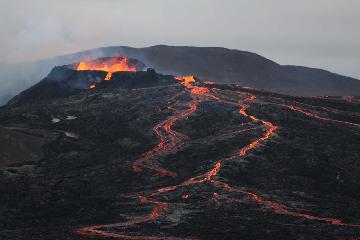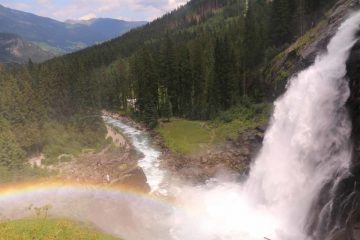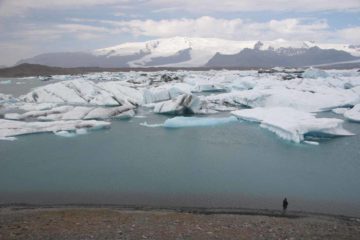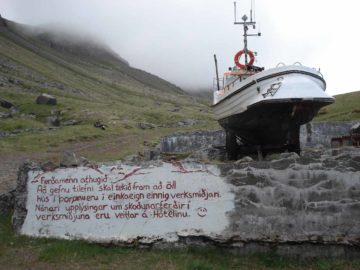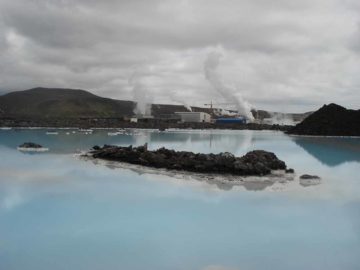About Haifoss
Haifoss (more accurately Háifoss; I think it’s pronounced “HAU-i-foss”) is said to be the second tallest waterfall in Iceland at 122m tall (at least that was the case in July 2007). But encyclopedic facts aside, what really made this waterfall stand out was that it was also accompanied by a similar waterfall called Granni (the Neighbor) in an adjacent gorge. Moreover, it seemed like we got lucky with the timing of our visit because not only did we see both waterfalls at their full flow, but the sun’s position was perfect as it yielded bright quarter-arcing rainbows within the mist of the main falls. Then, to top it all off, the falls was set amidst the hauntingly beautiful yet desolate landscape of the Icelandic Highlands. Add it all up, and we still think about this place whenever we reminisce about our 2007 trip to the country.
Walking to this waterfall from the car park (see directions below) was pretty easy. We took an easy-to-follow trail that went gently downhill until we got the best views of both Haifoss and Granni. We were at the falls between 10:30am and 11:30am in the early July on a sunny day, and that was when we saw the awesome rainbows making this one of the most surreal visual experiences we’d ever had on a waterfalling excursion. We spent around an hour away from the car, but I have to believe that most of that time was spent taking photographs and just chilling out here.
Both waterfalls were on segments of the Fossá River, which was a tributary of the larger Þjórsá River. While the Þjórsá River cut right through the wide and most desolate Þjórsadalur Valley, the Fossá cut a deep chasm making it unwise for us to try to access the shadowy base. And because the views of the falls were from the top of a deep chasm, we had to be careful not to get too close to the edges of the unstable cliffs.
Perhaps the greater drama in accessing the falls was more about the drive to get there than the physical exertion required. The road we took to get here was a pretty bumpy one, and I would imagine high clearance vehicles would be necessary to get here. But then again, we did see some low clearance 2wd vehicles at the car park, which would suggest it would be possible for such vehicles to make it, too. If that’s the case, driving carefully and slowly would have to be done or else risk damage to the undercarriage of the car, damage to the transmission, or even suffer flat tires from the rocks on the road.
As for the meaning of the waterfall’s name, I looked up my Icelandic dictionary and saw that “hár” means high. If that’s the case, then I guess its name could’ve been surmised given that the spelling of the name of the falls would likely induce a non-Icelandic speaker to think it’s pronounced “high”, anyways.
Finally, I had read that visitors to the re-created historical farm at Stöng may wish to undertake a long 5- to 6-hour trek to get to the falls as well as experience the lush rift area at Gjáin. That may be an option if you truly want to immerse yourself in the unforgiving highlands.
Related Top 10 Lists
Trip Planning Resources
Nearby Accommodations
This content is for members only. See Membership Options.Featured Images and Nearby Attractions
This content is for members only. See Membership Options.Visitor Comments:
Got something you'd like to share or say to keep the conversation going? Feel free to leave a comment below... Best waterfall in Iceland, hands down July 9, 2018 9:55 pm - We went because we were told it was impressive and not as crowded as the waterfalls over the South Coast. We made the right call by going there. Hot Damn, the waterfall is magnificent to look at and you can feel the sheer power of it, even if the point were you got to see… ...Read More
Best waterfall in Iceland, hands down July 9, 2018 9:55 pm - We went because we were told it was impressive and not as crowded as the waterfalls over the South Coast. We made the right call by going there. Hot Damn, the waterfall is magnificent to look at and you can feel the sheer power of it, even if the point were you got to see… ...Read More Amazing views! (Haifoss) September 5, 2015 9:14 am - We visited Haifoss as well as Gjain and Stong, all easily accessible by gravel roads, we did not have a high clearance 4x4 but we had absolutely no problem accessing the parking lots. We just drove slow- not a very long drive at all, maybe 10 minutes max. Beautiful area with wonderful views, if you're… ...Read More
Amazing views! (Haifoss) September 5, 2015 9:14 am - We visited Haifoss as well as Gjain and Stong, all easily accessible by gravel roads, we did not have a high clearance 4x4 but we had absolutely no problem accessing the parking lots. We just drove slow- not a very long drive at all, maybe 10 minutes max. Beautiful area with wonderful views, if you're… ...Read More Haifoss June 24, 2009 2:37 pm - WOW!!!! The drive there was bumpy and very long, but WOW!!! This is all you can say when you walk down the small trail to the falls and hear the sheer power of the water cascading over the edge. Two falls within a few meters of each other with the larger one falling straight on… ...Read More
Haifoss June 24, 2009 2:37 pm - WOW!!!! The drive there was bumpy and very long, but WOW!!! This is all you can say when you walk down the small trail to the falls and hear the sheer power of the water cascading over the edge. Two falls within a few meters of each other with the larger one falling straight on… ...Read MoreVisitor Reviews of this Waterfall:
If you have a waterfall story or write-up that you'd like to share, feel free to click the button below and fill out the form...No users have submitted a write-up/review of this waterfall

